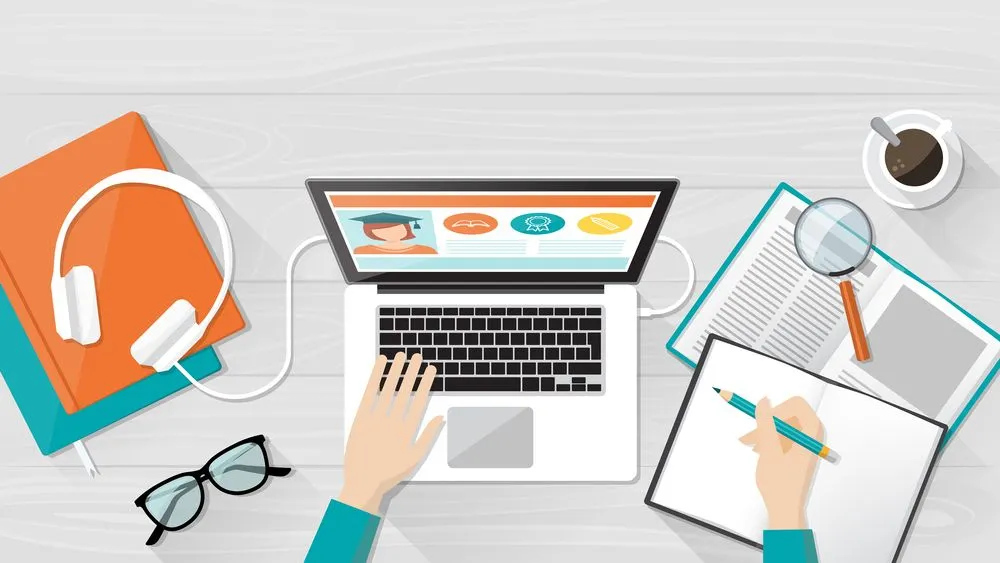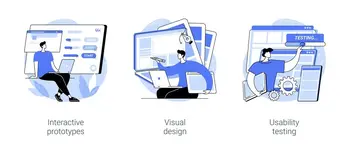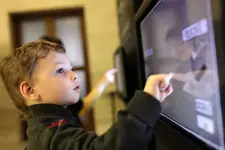
Table of contents
Interactivity in education is a big word right now. Teachers and researchers say it’s important for learning. Interactive learning means students are involved in the learning process. They get to participate, ask questions, and work with each other. This helps them learn more and think better.
A study by
Frontiers in Psychology
found that interactivity can help students learn better. It’s especially helpful when combined with active learning methods. Active learning methods like group work, interactive teaching, and collaborative learning get students involved and help them learn more.
The COVID-19 pandemic made interactive learning more important. Traditional classrooms were closed and students had to learn from home through educational technology. Interactive software and tools like interactive whiteboards, peer learning platforms, and online group projects helped improve student learning from each other and stay engaged.
As educators and researchers learn more about interactive technology, they’re finding that interactivity is an important part of learning. Interactive learning methods help students learn more and think better.
Why Interactivity is Important in Education

Interactivity is a big part of education that helps students pay attention, remember what they learn, and be more involved in their learning. Interactivity can enhance learning and improve student motivation. This section will explain why interactivity is important in school and how it helps students in these areas.
1. Attention and Retention
One of the best things about interactive technology in education is that it keeps students interested. When students are involved in the learning process, they are more likely to pay attention and remember what they are learning. Studies have shown that interactive learning can help students remember up to 60% more information than traditional lectures.
2. Student Engagement
Interactivity makes learning more fun and interesting for students. When students are engaged, they pay more attention and learn better. Interactive learning methods, like group work, discussions, and hands-on activities, let students work together and share their ideas. This type of engagement helps students learn more and be more interested in the subject matter.
3. Active Learning
Active learning is when students participate in the learning process. This is different from passive learning, where students just listen to the teacher and take notes. Active learning methods, like problem-based learning, case studies, and simulations,
help students think critically
and solve problems. These methods make learning more meaningful and relevant to students’ lives. Studies have shown that active learning methods can help students learn better and remember information longer.
In conclusion, interactivity is important for learning. It helps students pay attention, remember what they learn, and be more engaged. Interactive learning methods let students participate in their own learning, which makes them more motivated and interested. This leads to better grades.
Benefits of Interactive Technology in Education

Interactive technology has made a lot of good changes in education. It has changed how students learn and how teachers teach. Here are some of the good things about using interactive technology in school:
i. Enhanced Engagement
Interactive technology keeps students’ attention by using moving and colorful pictures. This makes it harder to get distracted and helps students stay focused on the lesson.
ii. Personalised Learning
Interactive tools can change to fit how each person learns and how fast they learn. This personal way of teaching helps students learn better by focusing on their strengths and weaknesses. This makes learning more effective and efficient.
iii. Active Participation
Technology that is interactive gets students involved in their learning. They can do things like play games, take quizzes, and have discussions. This helps them understand concepts better.
iv. Immediate Feedback
Tools like Formative and Pear Deck give students instant feedback on their work. This quick feedback helps students find and fix their mistakes right away, which leads to better learning.
v. Visualisation of Complex Concepts

Hard-to-understand or complicated ideas can be made easier to understand and see using interactive technology. This helps students learn difficult concepts by presenting them in a way that is more accessible and easy to grasp.
vi. Collaborative Learning
Interactive technology helps students work together. Virtual classrooms, discussion forums, and collaborative projects let students share ideas, work together, and learn from each other.
vii. Real-World Simulations
Virtual reality (VR) and augmented reality (AR) are computer technologies that create a virtual world or add digital information to the real world. This allows people to experience things that would be impossible or dangerous to do in real life, like flying a plane or performing surgery. VR and AR are especially useful in fields that require hands-on experience, such as science, medicine, and engineering.
viii. Access to Resources
Interactive technology makes it easy to find digital resources like e-books, online libraries, educational videos, and interactive tutorials. This helps students learn independently and explore new topics on their own.
ix. Global Learning Opportunities
Online platforms and virtual classrooms let students meet other students and teachers from all over the world. This helps them learn about different cultures and ways of thinking, which makes them better at working with people from different backgrounds.
x. Preparation for the Digital Age
Using technology in the classroom helps students learn the skills they need for the modern world. In today’s jobs, it is important to be able to use computers and other digital tools. Integrating technology in the classroom helps students develop these skills and prepares them for success in the future.
xi. Data-Driven Insights

Interactive technology collects information about how students are doing in school. Teachers can use this information to change their teaching methods, so that they can help students who are struggling and make sure that all students are learning.
xii. Lifelong Learning
Interactive technology helps people learn new things all the time. As technology changes, people can keep learning new things.
Interactive technology is good for education. It helps students learn better. It helps students learn at their own pace. It helps students work together. It helps students learn about the digital age. Interactive technology helps students learn the skills they need to succeed in the world.
Types of Interactive Learning
Interactive learning is a way of teaching that gets students involved. They don’t just listen to the teacher, they do things to learn. There are many types of interactive learning, like games, projects, and group work. Each type has its own benefits.
(a) Group Work
Group work is when students work together in small groups to learn. This helps them learn to collaborate, communicate, and think critically. It also helps them remember more of what they learn.
A
study
found that students remember only 5% of what they learn from lectures, but they remember 50% of what they learn from group discussions. Group work also allows students to share different ideas, which makes learning more interesting.
(b) Interactive Teaching
Interactive teaching is when teachers use technology and other stuff to make learning more fun and interesting. This can be done with games, quizzes, simulations, and even virtual field trips.
Interactive teaching makes students more motivated to learn and helps them understand things better. A
study
showed that students who did interactive teaching activities scored a lot higher on tests than those who didn’t.
(c) Peer Learning

Peer learning is when students teach and learn from each other. This can happen in a formal setting, like a classroom, or an informal setting, like a study group. Peer learning is a student-centred approach to learning, which means that students are more active in their own education.
Peer learning has been shown to have many benefits for students. It can help students improve their confidence, communication skills, and critical thinking abilities. A
study
found that students who participated in peer learning activities had higher academic achievement and were more likely to persist in their studies.
(d) Learning by Teaching
Learning by teaching is a way for students to learn by teaching others. They teach their classmates or younger kids about a topic. This helps them understand the material better because they have to explain it to someone else.
Learning by teaching has been shown to help students learn more and remember what they learn. It also helps students feel more confident and motivated. A
study
found that students who participated in learning-by-teaching activities did better in school and were more likely to go to college.
In conclusion, interactive learning is a great way to teach students. It helps them learn, be motivated, and do well in school. Teachers can use group work, interactive teaching, peer learning, and learning by teaching to create a more fun and engaging learning environment for their students.
Tools and Software for Interactive Learning
Learning with interaction is getting more and more common in schools. This is because technology can help teachers make lessons more fun and interesting for students. Different learning styles can be supported with interactive lessons. In this section, we will look at some of the most popular tools and software for interactive learning.
1. Interactive Whiteboards

Interactive whiteboards are a cool tool for making lessons more fun. They let teachers show pictures, videos, and other stuff on the board, and write on it too. The teachers can also change the stuff on the board and make it move around. A study by the National Center for Education Statistics found that 96% of public schools in the United States have interactive whiteboards in their classrooms. Some popular brands of interactive whiteboards are Promethean, SMART, and Mimio.
2. Collaborative Learning Software
Collaborative learning software helps students work together on projects. It lets them share ideas and give feedback to each other. Some popular collaborative learning software programs are Google Classroom , Microsoft Teams , and Canva . A study by EdTech Magazine found that most K-12 teachers use collaborative learning software in their classrooms.
3. Project-Based Learning Tools
Project-based learning is a teaching method where students learn by doing projects. These projects are real-world and hands-on, so students get to use the skills they are learning in a real-world setting. Project-based learning tools help students with their projects by giving them resources like research tools, project management software, and presentation tools. Some popular project-based learning tools are
Trello
,
Prezi
, and
Canva
.
In conclusion, there are many tools and software that can be used for interactive learning. Interactive whiteboards, collaborative learning software, and project-based learning tools are just a few examples. By using these tools in their lessons, teachers can create engaging and interactive learning experiences for their students.
Evaluation and Analysis of Interactive Learning

Interactive learning is a great way to learn because it gives you feedback right away. This feedback helps you understand your strengths and weaknesses so you can improve. You can evaluate interactive learning methods by taking surveys, quizzes, and tests. These evaluations will help you see how well you are learning and what you need to work on.
You can also analyze interactive learning methods by looking at data. This data can show you where students are struggling so you can improve the methods. You can use software to track student progress and learn about their learning patterns.
ICT has made it easier to evaluate and analyze interactive learning methods. With technology, you can track student progress and give feedback right away. You can also collect data and analyze it to see where students are struggling.
A
study
found that students only remember 5% of what they hear in a lecture. But they remember 50% of what they discuss and 75% of what they practice. This shows that interactive learning methods are more effective than traditional lecture-based learning.
In conclusion, evaluation and analysis are important parts of interactive learning. They help you improve your methods and make sure you are learning effectively. ICT has made it easier to evaluate and analyze interactive learning methods. Interactive learning methods are more effective than traditional lecture-based learning.
The Impact of the COVID-19 Pandemic on Interactive Learning
The COVID-19 pandemic has had a big effect on school and learning. When schools suddenly started teaching online, it messed up the usual way teachers teach. One of the things that was hurt the most was interactive learning. Interactive learning needs students and teachers to talk to each other and work together in person.
i. Online Learning

The COVID-19 pandemic made schools move their classes online. This led to more use of virtual learning environments and video conferencing tools. These tools helped students learn, but they also made it harder for students and teachers to talk and work together in real-time. This decreased the amount of interactive learning in schools.
Here are some specific examples of how online learning has made it harder for students and teachers to interact:
- It is harder for students to ask questions and get help from teachers when they are not in the same room.
- It is harder for students to work together on group projects when they are not in the same place.
- It is harder for teachers to see how students are understanding the material and to give them feedback.
These challenges can be overcome by using different teaching strategies and by using technology in a more creative way. For example, teachers can use online polls and quizzes to check for understanding, and they can use breakout rooms to allow students to work together on projects. They can also use video conferencing tools to give students more individualized attention.
By using these strategies, teachers can make online learning more interactive and engaging for students.
2. Virtual Presentations
Virtual presentations are like online shows. They have some good things, like showing pictures and videos and letting people watch from far away. But they also have some bad things. They don’t have the same face-to-face talking and listening that you get in a real classroom. This can make it hard for students to pay attention and ask questions.
To fix this problem, teachers have had to find new ways to make virtual presentations more interactive. They have used things like breakout rooms, polls, and group chats to let students talk to each other and the teacher during the presentation.
The COVID-19 pandemic has made interactive learning harder. But teachers are finding new ways to make it work. They are using technology to keep students engaged and learning.











